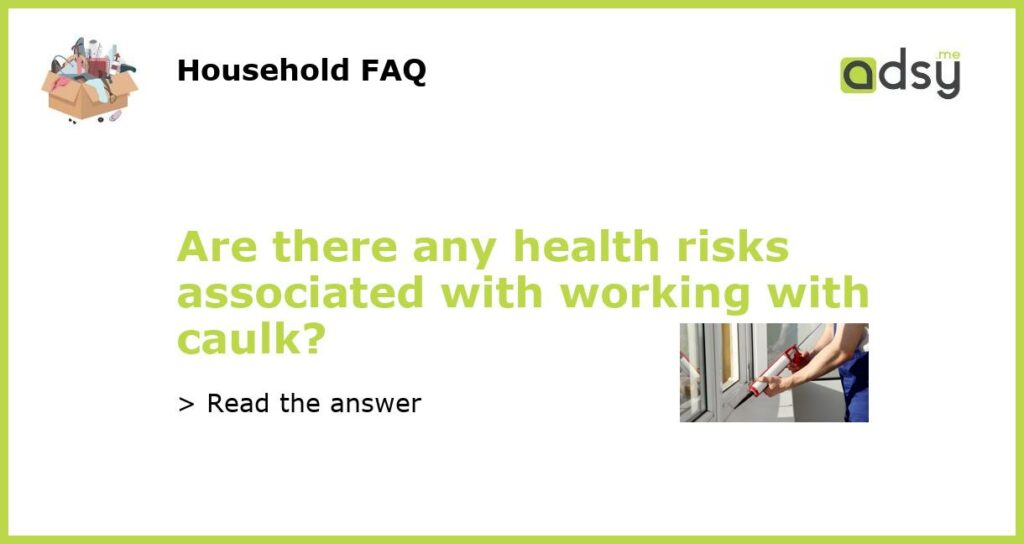What is caulk?
Caulk is a versatile material used in construction and home improvement projects. It is a type of sealant that is used to fill gaps, cracks, and joints in various surfaces such as wood, concrete, and metal. Caulk is commonly used to create a waterproof barrier and prevent air or moisture infiltration. It comes in different forms, including silicone, acrylic, and latex-based caulk.
Potential health risks of working with caulk
While caulk is generally considered safe to use, there are some potential health risks associated with working with this material. The primary concern is the exposure to harmful chemicals that may be present in certain types of caulk, such as silicone caulk.
Silicone caulk typically contains volatile organic compounds (VOCs) like toluene, xylene, and formaldehyde. Prolonged or excessive exposure to these chemicals can have negative health effects, including respiratory irritation, dizziness, headaches, and allergic reactions. In some cases, long-term exposure to VOCs has been associated with more serious health conditions, such as cancer.
Precautions to minimize health risks
To minimize the potential health risks associated with working with caulk, it is important to take certain precautions:
1. Ventilation: Ensure that the work area is well-ventilated by opening windows or using fans to help dissipate any fumes or vapors. This will help reduce the inhalation of harmful chemicals.
2. Personal protective equipment (PPE): Wear appropriate PPE, such as gloves, safety goggles, and a respirator, when working with caulk. These items will provide a barrier between the skin and the chemicals, reducing the risk of exposure.
3. Choose low VOC or VOC-free caulk: Opt for caulk products that have low VOC content or are VOC-free. These types of caulk contain fewer harmful chemicals, making them safer to use.
4. Read and follow product instructions: Always read the product label and follow the manufacturer’s instructions for safe use. This includes proper handling, application, and disposal of caulk.
5. Clean up properly: Dispose of used caulk containers and clean up any spills or excess caulk immediately. Avoid contact with skin and eyes, and wash hands thoroughly after handling caulk.
By following these precautions, the risks associated with working with caulk can be minimized, making it safer for both professionals and DIY enthusiasts.
Alternatives to caulk
If you are concerned about the potential health risks of working with caulk, there are alternative materials that can be used to fill gaps and seal joints:
1. Water-based sealants: Water-based sealants, such as water-based silicone or acrylic sealants, are considered to be safer alternatives to caulk. They have lower VOC content and are less likely to release harmful fumes or vapors.
2. Weatherstripping: Weatherstripping is another option for sealing gaps and preventing air or moisture infiltration. It is commonly used around doors and windows and is available in various materials, including rubber, foam, and adhesive-backed strips.
3. Tape: Certain types of tape, such as duct tape or adhesive-backed tape, can be used to temporarily seal gaps or cracks. However, tape is not a permanent solution and may need to be replaced periodically.
4. Foam sealants: Foam sealants, like expanding foam or spray foam, can also be used to fill larger gaps or cavities. These sealants harden and create a durable barrier against air and moisture intrusion.
It is important to choose the appropriate alternative based on the specific application and requirements of the project. Consult with a professional or read product labels for guidance.
Conclusion
Working with caulk can pose potential health risks due to the presence of harmful chemicals, particularly in silicone caulk. However, by taking proper precautions like ensuring good ventilation, wearing protective equipment, choosing low VOC or VOC-free caulk, and following product instructions, these risks can be minimized. Additionally, there are alternative materials available, such as water-based sealants, weatherstripping, tape, and foam sealants, that can be used as safer alternatives to caulk. It is important to assess the specific requirements of the project and choose the appropriate material accordingly. By being aware of the potential risks and taking necessary precautions, working with caulk can be done safely and effectively.

